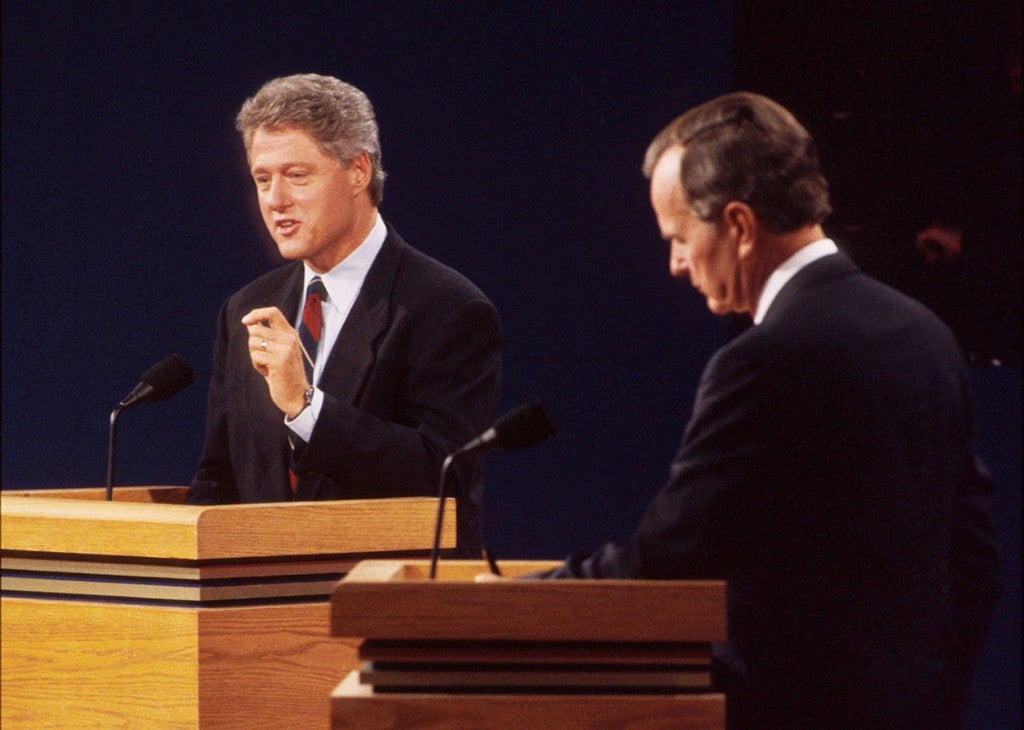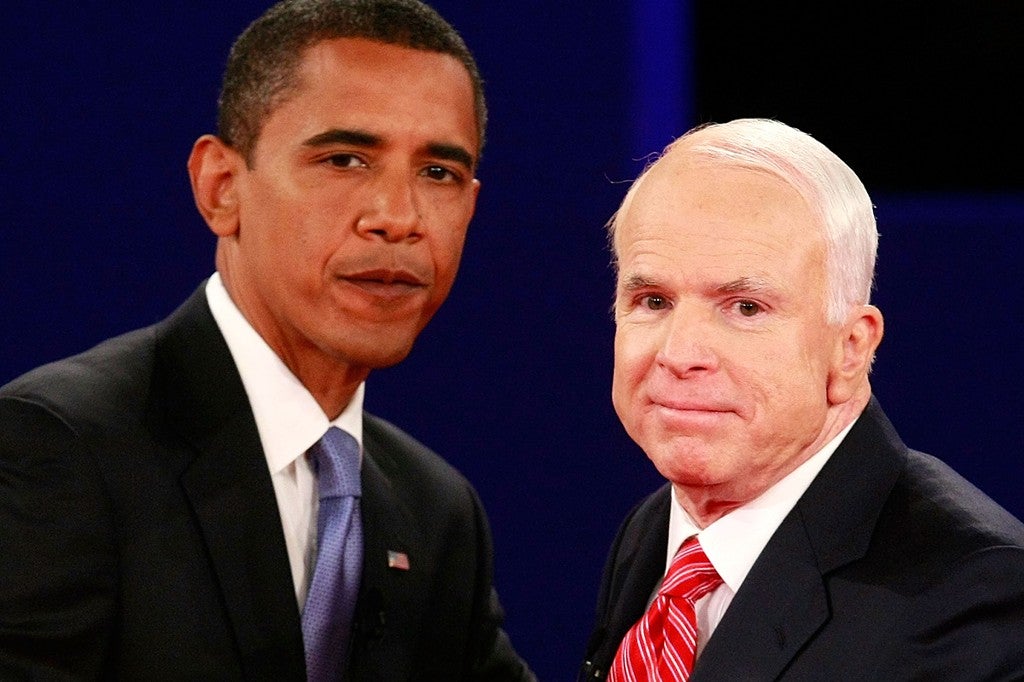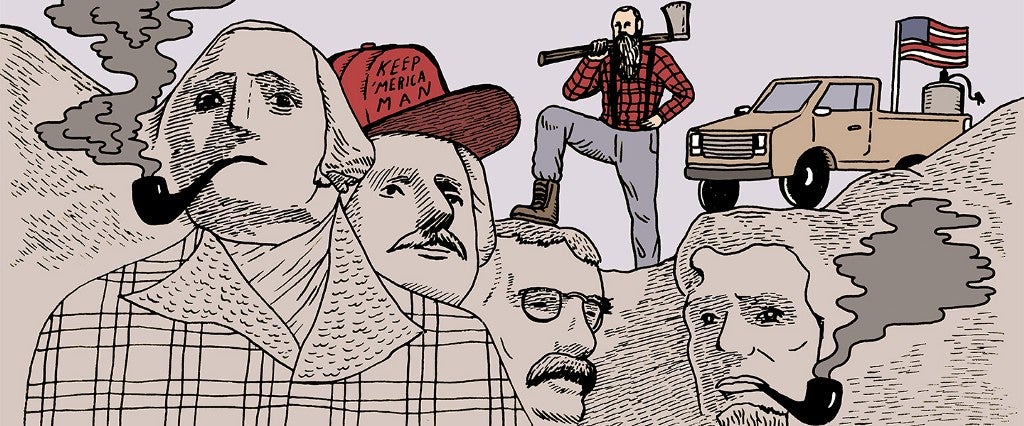Donald Trump’s unexpected popularity in the 2016 election largely hung on a singular perception: He’s a real man.
“Finally someone with balls,” read a T-shirt at a Trump rally in Daytona Beach.
“Real men vote 4 Trump,” proclaimed a sign at Trump’s L.A. headquarters.
The most common endorsement among supporters — that “he tells it it like it is” — was equally effective at distinguishing Trump’s “no-bullshit masculinity” from his more contemplative, feminine opponents (and predecessors) and rationalizing his more egregious fuckups.
“I like Trump because he isn’t a politician, he talks like a guy,” explained Scott Baio after Trump’s “grab ’em by the pussy” comment went public. Trump also went after his Republican opponents one-by-one for not being man enough for the job: Jeb Bush was “low-energy” and Marco Rubio was “little.”
In his 2016 book, Man Enough? Donald Trump, Hillary Clinton and the Politics of Presidential Masculinity, author and filmmaker Jackson Katz explains that running on a platform of hyper-masculinity isn’t anything new in America — at least not for the GOP. Over the last 40 years, the Republican party has won the vast majority of white men by a) reaching out to them in racially coded ways (e.g., Richard Nixon’s Southern Strategy); and b) marketing themselves as the party of “real men” (e.g., Swift Boat Veterans for Truth). If you’re a real man, you’re a tough man — tough enough to understand what needs to be done in a dangerous world.
“The presidency as an institution in many ways has always reflected what America considers to be the qualities of a real man: strong, hegemonic and dominant,” Katz tells me. “It occupies a unique cultural terrain — combining elements of a king and a chief executive because what the president does and how they present themselves has so much to do with the national identity. So if the country sees itself as very masculine and the presidency as a very masculine institution, which it does, the person who occupies that position embodies the national manhood.”
Katz thinks this has been especially true since Nixon’s re-election campaign in 1972 — the moment he believes presidential politics became an ongoing cultural struggle over the definition of American manhood. His evidence…

1972: Nixon and the Hard Hats
Nixon’s resounding 49-state landslide victory over Democratic Sen. George McGovern was preceded by journalist Pete Hamill’s 1969 essay “The Revolt of the White Lower Middle Class,” which captured the rage of blue-collar men in white ethnic communities in the urban north who felt neglected and abandoned. (Sound familiar?) “A large reason for the growing alienation of the white working class is their belief that they are not respected,” Hamill wrote. “It is imperative for New York politicians to begin to deal with the growing alienation and paranoia of the working-class white man.”
That’s exactly what Nixon did. His Labor Department delivered a report entitled, “The Problem of the Blue-Collar Worker,” echoing many of the grievances introduced by Hamill. Nixon also is responsible for OSHA, or the Occupational Safety and Health Act. It was, according to Nixon, “one of the most important pieces of legislation, from the standpoint of the 55 million people who will be covered by it, ever passed by the Congress of the United States.” Katz explains that by positioning itself squarely on the side of the hard hats (as opposed to the smelly longhairs), the GOP became the party of “real (white) men” while the Democrats were increasingly perceived as the party of hippies and pampered, feminized elites.
1980: Reagan vs. Carter
It was the Iran hostage crisis in particular that exposed Carter’s manly shortcomings (i.e., the idea that he was soft on terrorism). “He was too conciliatory, too nice,” Katz explains. “He wore cardigan sweaters, had big teeth and smiled too much. He was deficient in the one quality that mattered most — he wasn’t man enough for the job.” Critics claimed the U.S. had become an “impotent giant.” It was much easier to maintain that Carter’s supposed weakness as a man had somehow allowed the Iran hostage debacle to occur than it was to blame U.S. policy stretching back decades, namely its perceived attempts to undermine the Iranian Revolution and its longstanding support of the recently overthrown Shah.
On the flip side, Reagan appeared on the presidential scene with the swagger of a sheriff fixin’ to save the day. His “hard” masculinity — decisive, tough, John Wayne-esque —created the impression that he would take care of business and create a new conservative template for white male leadership, which had been softened by two decades of civil rights, women’s liberation and the LGBT movement. Critics accused Reagan of being intellectually shallow and a lazy cowboy—unsophisticated and unqualified to be a leader. But according to Katz, this criticism backfired (as it would against George W. Bush decades later), as millions of white men took it personally when cowboys were ridiculed. The term had come to represent idealized qualities of traditional (white) masculinity: rugged individualism, eye-for-an-eye justice and no-nonsense straight talk.
Reagan particularly excelled there, as his anti-intellectualism shined through — he often stumbled badly, frequently misstating facts and his administration’s position on complex issues. “In light of the way George W. Bush in the 2000s was the target of relentless ridicule, it is interesting to speculate about whether Ronald Reagan’s stage managers would have been as successful in heroizing him in the 1980s if programs like The Daily Show were around to run video replays of his numerous gaffes, factual misstatements and inarticulate ramblings,” Katz notes.
Most people overlooked Reagan’s deficits because they were emotionally invested in the myth of the aging white patriarch restoring American pride through masculine assertions of discipline at home — and military muscle abroad. In 1984, Reagan campaigned on a slogan of “peace through strength,” using media to stoke the American public’s fear of the Soviets. His “Bear in the Woods” commercial became one of the most famous political ads of the 1980s.
The metaphor was clear: Vote for Ronald Reagan if you’re a man (or woman) who understands the dangers in the world and wants a government led by a man who won’t hesitate to use the overwhelming power of the U.S. military in order to protect you and your family.
1988: George H. W. Bush vs. Michael Dukakis
As Katz explains, Michael Dukakis held a commanding 17-point lead over Bush in public opinion polls early in the 1988 campaign; third terms are impossible for a single party, right? Then, Bush went on the offensive under the leadership of a young political consultant from South Carolina named Lee Atwater who understood that if you attack a candidate’s manhood, he’ll have a difficult time winning the votes of white men.
And that’s exactly what the Bush campaign did, hitting Dukakis on three issues centered around masculinity: patriotism, prison furloughs and national security. Dukakis’s furlough of Willie Horton, Bush claimed, was evidence of Michael Dukakis’s failed manhood: He couldn’t even protect white women from black male aggressors. (While furloughed, Horton twice raped a local woman after pistol-whipping, stabbing, binding and gagging her fiancé.)
Bush himself also ridiculed Dukakis because, as the governor of Massachusetts, Dukakis wouldn’t sign a law criminalizing teachers who refused to put their hands on their chests for the pledge of allegiance. Bush even held a press conference in front of a flag factory in New Jersey to call attention to Dukakis’s lack of patriotism. “It was an outrage,” Katz says. “Michael Dukakis was every bit as patriotic as George H. W. Bush, but it was more about respecting the institution of democracy rather than an aggressive, flag-waving, chest-beating patriotism — and therefore not as manly.”
The result? Bush won 40 states and trounced Dukakis in the Electoral College, 426–111.

1992: Bill Clinton vs. George H. W. Bush
When it came to the cultural politics of white manhood — an area long mastered by the Right — Clinton brought a number of strengths. Despite his academic pedigree, his nickname was “Bubba,” and he came from a dysfunctional, blue-collar family in the South that he wasn’t ashamed to talk about. He was also “tough on crime” — calling for 100,000 new police officers on the street. This directly addressed the Right’s claims that liberals, progressives and feminists “coddled” criminals instead of getting tough on them. “Who ‘coddles’ in the real world?” Katz asks. “In other words, it’s another feminizing metaphor to make it seem as if ‘Republican’ equals strength and masculinity while ‘Democrat’ equals softness and femininity.”
Clinton obliterated any such remaining characterization when, just weeks before the New Hampshire primary in January 1992, he interrupted his presidential campaign to return to Arkansas to sign a death warrant for Ricky Ray Rector, a mentally impaired 30-year-old African-American man who had been convicted in the 1981 murder of a white police officer. In Southern states — where the vast majority of executions have occurred in recent decades — the death penalty was often used as a litmus test for executive leadership. “Clinton’s support for the death penalty was seen — especially in the South — as a fundamental marker that he was tough enough to be a political leader,” Katz says.
George W. Bush vs. John Kerry
George W. Bush purchased a ranch in Crawford, Texas in 1999 — just before his first presidential campaign began — presumably to provide a visual backdrop for endless photos depicting him as a down-home cowboy in the Regan mode, who liked to wear blue jeans, clear brush and ride around in pickup trucks.
As Katz points out, Democrats who criticized Reagan and later W. as reckless cowboys were shortsighted and self-defeating. As Danny Goldberg advised progressive readers of The Nation after Bush soundly defeated Kerry in 2004, in future elections Democrats “need candidates who understand that part of the job description for political leadership is fluency in mass American cultural language, a language in which, for example, the word ‘cowboy’ is a compliment, not an insult.”
Bush’s landing on an aircraft carrier in a flight suit in front of a “Mission Accomplished” banner in 2003, Katz says, was exactly the kind of cartoon theatrics Reagan had successfully deployed decades earlier. “Here’s George W. Bush, born of aristocratic privilege, in front of working-class troops applauding him and cheering him on. Now that’s a masculine president.”

2008: McCain vs. Obama
Katz notes that while sports can help candidates forge a bond with voters, they can also exacerbate racial and class differences. On a campaign stop in Pennsylvania prior to the primary, Obama was supposed to shake hands with bowlers, but instead, he got out on the floor and bowled a few frames himself. He threw a number of gutter balls and scored a pitiful 37. The right-wing media referenced it repeatedly in the next few months as evidence that the city-slick African-American senator wasn’t “one of us.” Or as Joe Scarborough said: “Americans want their president, if it’s a man, to be a real man. You bowl 150, you’re a man.”
Granted, Obama is hardly unathletic — he’s known for his love of basketball, and in fact his brother-in-law was the head basketball coach at Oregon State and at Brown. But Katz points out that basketball has been coded in the last 25 years as a black, urban sport. The fact that Obama was good at basketball and used basketball metaphors was something that might have connected him to younger and African-American voters, but it alienated him from white, working-class ones.
Still, Katz notes, “Obama was able to project a kind of cool masculine competence in a way that attracted not only the overwhelming majority of black voters, but also the largest number of white male voters for a Democratic presidential candidate in over 30 years. The fact that Obama won the most white male votes (41 percent) of any Democrat since Jimmy Carter in 1976 prompts its own set of questions: What was it about Obama’s masculinity — not simply his blackness — that proved attractive to millions of white male voters?”
Obama’s charisma played a role, as did Hollywood. As Katz points out — and as movie critics Manohla Dargis and A.O. Scott wrote in The New York Times — Americans were ready to see a black man as president because they had already seen several on the big and little screen: “The presidencies of James Earl Jones in The Man, Morgan Freeman in Deep Impact, Chris Rock in Head of State and Dennis Haysbert in 24 helped us imagine Mr. Obama’s transformative breakthrough before it occurred. In a modest way, they also hastened its arrival.”
Obama’s decision to organize and authorize an elite team of Navy Seals to kill Osama bin Laden changed the narrative about his manhood, Katz says, and dealt a stunning blow to a central tenet of modern right-wing propaganda — that Democrats are inherently timid about the use of force, and thus insufficiently manly to lead. “One caller to the (liberal) Stephanie Miller Radio Program summed it up like this: By killing the most wanted man in the world, ‘Obama went from Urkel to Shaft.’”
Trump vs. ? in 2020
What’s next? If Trumpism is a white male identity movement pushing back against the cultural conversation about women, people of color and the LGBT community, what will be the most effective pushback against Trumpism? Someone who is even more hyper-masculine? Katz points out that while presidential success over the last 50 years has largely corresponded to elements of manhood, hyper-masculinity needn’t be the only factor. “If the Democrats nominate somebody who can more directly and credibly speak to working-class anxieties about economic matters — as Bill Clinton did in the 1990s — I think they will be well-positioned in 2020,” he says.
An embrace of populism is precisely what hardcore progressives like Michael Moore prescribe. “Why don’t we run beloved people?” he asked on CNN’s State of the Union. “The Republicans do this — they run Reagan and the Terminator and other people.” Celebrities who have registered an interest in running for political office include Will Smith, Angelina Jolie, Roseanne Barr and Dwayne Johnson — and seem like unrealistic candidates. But then again, the guy who used to host The Apprentice is now our president-elect.
So why not the ultimate movie everyman — the guy that everyone can relate to?
President Tom Hanks, anyone?

